The Nissan Townstar Electric has a payload of between 600kg and 800kg. It also gets a towing capacity of up to 1,500kg.
Home »
Nissan has opened the order books for the new Nissan Interstar van with the entry-level model priced from £33,090.
Diesel versions of the all-new Interstar will be available in two trim levels, Acenta and Tekna, with power options from 103hp to 167hp using a 2-litre turbodiesel engine. A full electric version of the Nissan Interstar Electric will follow in 2026.
Sharing its platform with the new Renault Master, Nissan will also offer a range of factory-built conversions with tipper, drop-side and box van options. There will also be several panel van versions with two possible body lengths and two roof heights allowing L2H2, L3H2 and L3H3 variants. There will also be the choice of six-speed manual transmission or nine-speed automatic gearbox.
Safety equipment levels have been improved with the new Interstar now getting a Forward Emergency Braking, Drowsiness Warning and a Tyre Pressure Monitoring System as standard. Nissan also says the reaction time for its emergency braking will be half that of the previous generation.
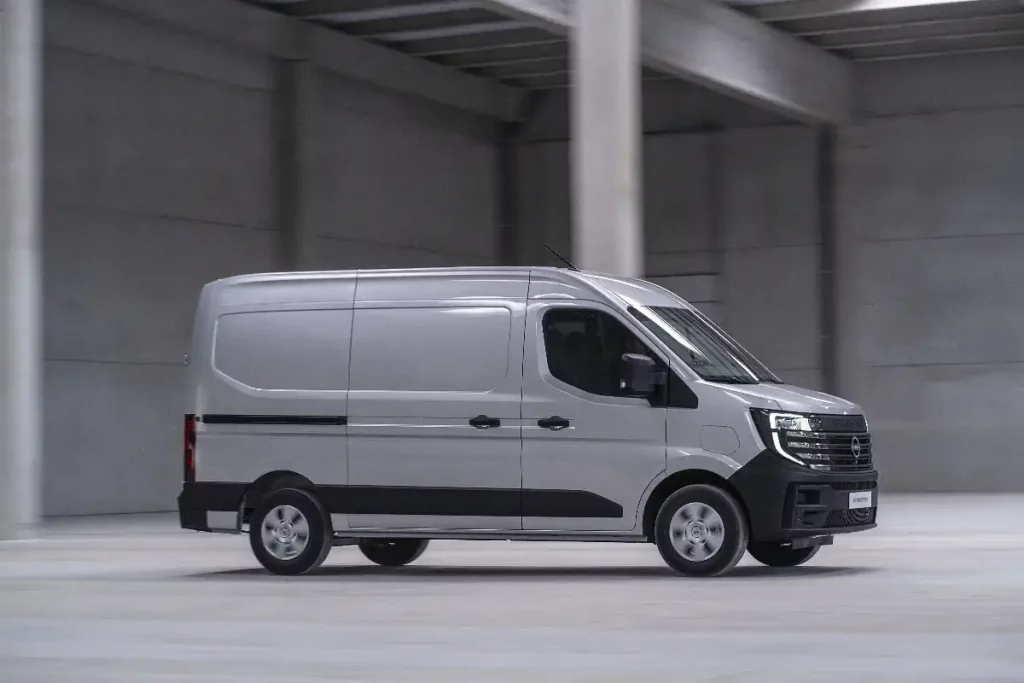
Other standard systems include Lane Keep Assist, Lane Departure Warning, Intelligent Speed Assistance, Intelligent Emergency Braking with cyclist and pedestrian detection and Side Wind Assist.
On the inside, manual air-conditioning will be standard along with a 10.1-inch touchscreen that has been angled towards the driver to improve visibility. The Interstar also gets two large cup holders, overhead shelves and 10 open storage areas. There are also three closed areas and a multipurpose central seat-back workspace and under-seat storage box.
Top trim level Tekna vans will cost an additional £1,200 + VAT over the Acenta variants and get the following additional equipment.
Most importantly, the Nissan Interstar will come with a five-year or 100,000-mile warranty.
Pre-orders for the Interstar diesel van are open now with sales expecting to begin on 1 October 2024.
UK demand for new light commercial vehicles (LCVs) surged by 21.0% in 2023, reaching 341,455 units, as per the latest data from the Society of Motor Manufacturers and Traders (SMMT). Each month, more businesses invested in fleet renewal compared to the previous year, resulting in a record influx of zero-emission vans onto Britain’s roads.
In 2023, an additional 59,316 LCVs of various types and sizes were registered compared to 2022, following a £2 billion increase in spending by companies fulfilling essential roles in the economy, spanning from local trades to online delivery services. December notably experienced a 36.1% surge in demand, marking the strongest month since 2015. As a result of increased vehicle investment throughout the year, 2023 witnessed the highest demand for new vans since the sector’s post-pandemic recovery in 2021, with the market just -6.6% below 2019 levels.
Demand for the largest vans (weighing more than 2.5 tonnes to 3.5 tonnes) continued to rise by 9.4%, representing 66.9% of all new van registrations, driven by operators opting for payload efficiencies. Medium-sized vans (above two tonnes to 2.5 tonnes) saw the largest growth, surging by 78.4% to 57,992 units, catering to urban operators' requirements for heavy load carrying capacity and smaller vehicle sizes.
New battery electric vans (BEVs) witnessed a positive trend, reaching record volumes with a 21.0% increase to 20,253 units, constituting 5.9% of the market. December saw a remarkable 73.8% surge in BEV uptake, with the greenest vehicles representing 10.0% of registrations, marking the second-highest monthly BEV share.
The Ford Transit Custom was the best-selling model of the year, followed by its larger sibling the Ford Transit dimensions. Third place in the rankings went to the Vauxhall Vivaro dimensions and the first and only pick-up truck in the top ten was the Ford Ranger.
Despite these advancements, the Zero Emission Vehicle Mandate, mandating 10% of every van manufacturer’s sales to be BEVs this year, poses challenges. Flatlined BEV market share in 2023 compared to 2022 highlights the need to align LCV demand with supply, necessitating immediate action to address barriers to BEV uptake, particularly the shortage of van-suitable public chargers. A sustained commitment to the Plug-in Van Grant is essential for facilitating a seamless transition across all sectors and regions of the country.
Nissan has revealed its next generation of large van, the Nissan Interstar. Built on an entirely new platform, the Interstar replaces the Nissan NV400 model and is a sister-model to the Renault Master and Renault Master E-Tech.
Here's what you need to know about Nissan's new large van.
The design was done in London at Nissan Design Europe in Paddington. The main focus is on the front three-quarters. The designers have tried to combine the interlocking grille, from the existing range of commercial vehicles, with the new generation of V-Motion grilles from the passenger cars – implemented through the lighting and integration with the headlamps.
The grille takes up the full width of the vehicle which has a big impact on the design, and the name Interstar is on the grille. It’s also the first time Nissan has had an electric vehicle in the large van sector with the Interstar-e
There are definitely a lot of vertical lines going on. Nissan says that these are air curtains designed to improve the aerodynamics of the vehicle and improve the airflow around the vehicle. Aerodynamics is the key watchword, with a tapered rear of the vehicle and new aerodynamic mirrors. Overall, there’s a 20% improvement in aerodynamics which improves both the electric and diesel powertrain efficiency.
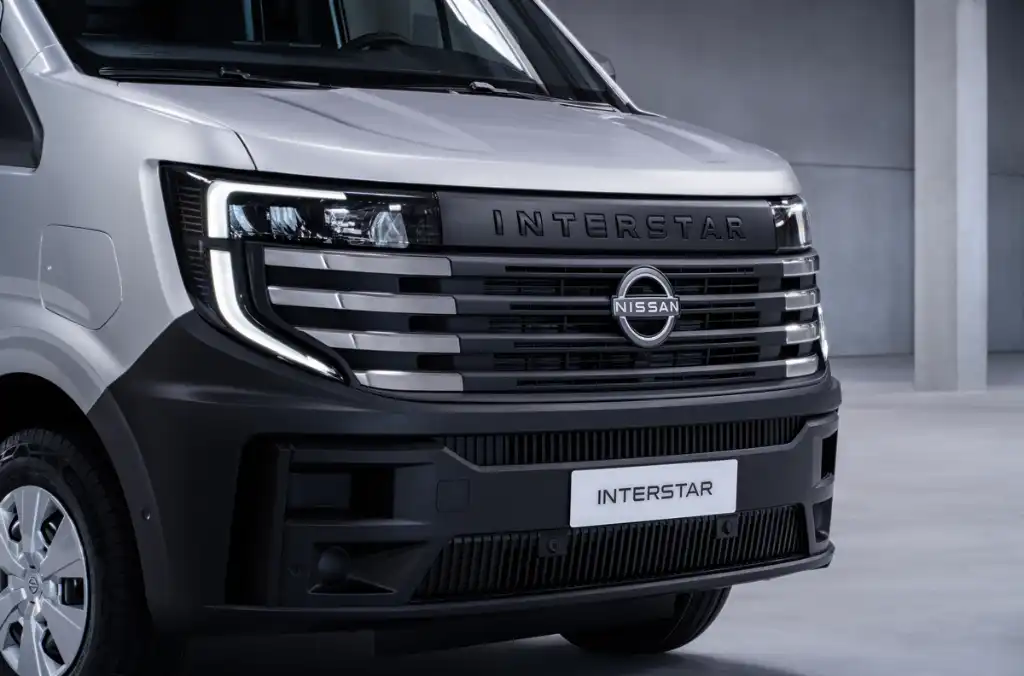
Nissan says all areas of the cabin have been improved with more space around the driver and elbow room at the windows.
It’s a new generation of interior, that’s very modern and driver centric with a HGV feel to the layout. There’s also a 10-inch main central display with a 7-in digital dash display for the EV.
There’s a new M920 diesel engine with a single turbo. That’s a 2-litre diesel engine with 130hp, 150hp and 170hp outputs. Standard with a manual gearbox but also available with a 9-speed automatic from ZF that replaces the old robotised manual auto – only available with the 150hp and 170hp versions.
There are two different battery sizes available in the Nissan Interstar-e with a 40kWh battery offering 200km claimed range, or a 87kWh battery with a claimed range of 460km (285 miles).
The smaller battery gets a 96kW battery with 300Nm of torque. The larger battery gets a 105kW motor that also produces 300Nm of torque.
The small battery charges at 50kW while the larger battery can cope with up to 130kW. At the fastest speeds it can add 252km of range in just 30 minutes. AC charging is at 11kW and 22kW charging are both available for the larger battery. A 10-100% recharge will take less than 4 hours for the large battery at 22kW.
The new model expands the range to include 3.3, 3.5 and 4-tonne variants. On the EV there’s also a 3.5, 3.8 and 4-tonne versions. There’s also body conversions including, crew van, dropside and tipper. Nissan has dropped the smallest L1 length van and will only offer L2 and L3 vans. There’s two heights with H2 and H3 models. In total, load volume will be from 10.8m3 to 22m3.
Nissan stopped making the Cabstar in 2019 due to emissions legislations and hasn’t have a replacement vehicle on sale in the UK since then. However, Nissan thinks that the availability of dropside and tipper options on the Interstar give them a similar option. “We thank that the open body versions can bring an offer that’s really appealing to NT400 and Cabstar customers who really appreciate the usability,” Andrew Limbert, Nissan LCV product and marketing.
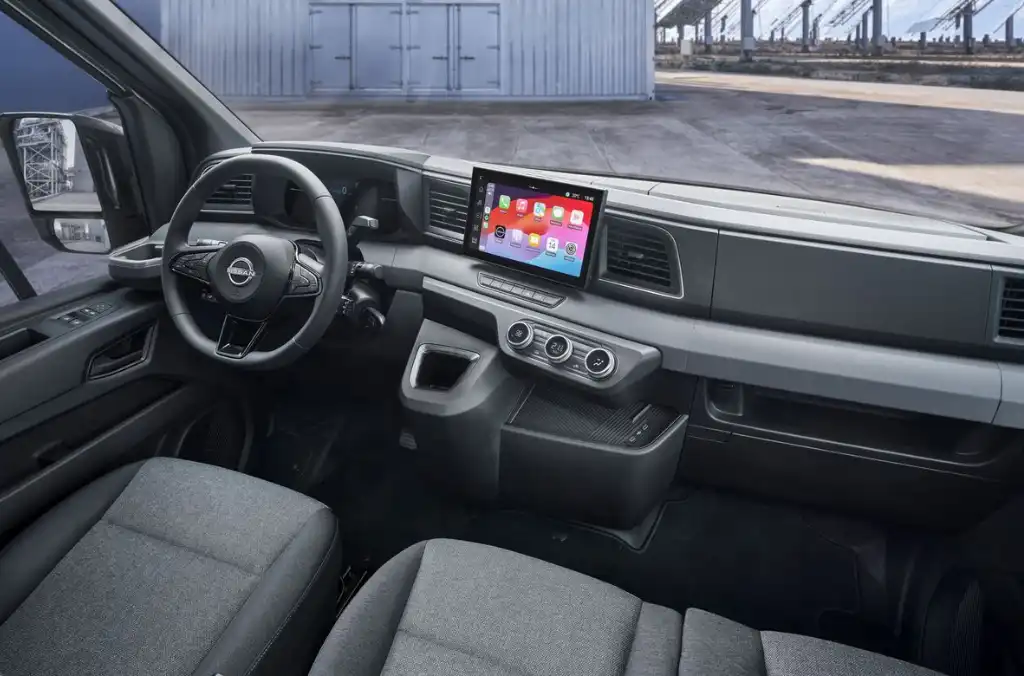
Cruise control, lane keeping assist, drowsiness warning, emergency stop and tyre pressure monitoring and rear parking sensors are all standard.
Nissan says there won't be any other variants other than the front-wheel-drive vans for the right-hand-drive markets. That's because the majority of sales are for FWD 3.5-tonne vans.
Pre-sales for the Nissan Interstar will begin in Q3 and deliveries will start from Q1 2024. Nissan expects sales to be 90% for the diesel model and hope to double their sales.
Nissan says you don't really sell the majority of their vans through their 37 dedicated LCV sites in the UK, rather than in the regular passenger car dealers.
Nissan has unveiled the new Nissan Townstar Van L2 (long wheelbase) model, the latest addition to its light commercial vehicle (LCV) lineup in Europe.
The new model caters to the evolving needs of SME owners and fleets with an extended length of 4910mm. This makes it nearly comparable to the size of a mid-sized van. The additional length allows for a wider side door of 831mm, enabling customers to load one Euro pallet and providing greater loading options compared to competitors.
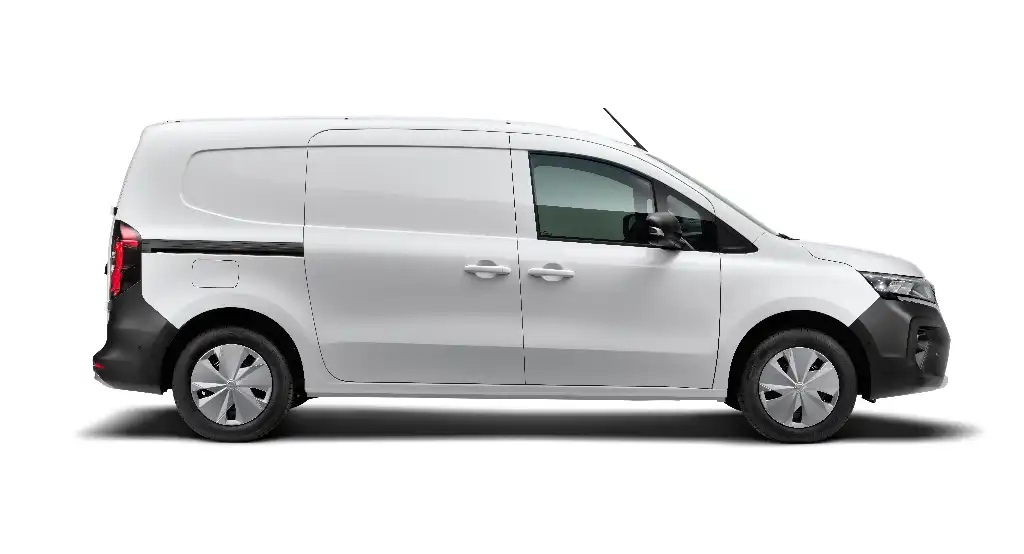
Cargo capacity for the Townstar Van L2 is an impressive 4.3m³ up by one cubic metre from the L1 model's capacity of 3.3m³.
The van can still accommodate two Euro pallets while offering additional space. Moreover, the new model has a payload capacity of up to 800kg, thanks to revised rear suspension, and maintains a maximum towing capacity of 1,500kg.
The Townstar Van L2 is available in both electric and internal combustion engine (ICE) versions.
The Nissan Townstar Electric variant offers an urban cycle range of up to 242 miles and a total combined range of up to 171 miles.

It comes with a 45kWh battery that allows for AC (11/22 kW) or DC charging (up to 80kW) and has a 90kW motor with 245Nm of torque.
The van is equipped with a number of safety features common in Nissan models, including Blind Spot Warning, ProPILOT, and the unique-to-segment Intelligent Around View Monitor giving a 360-degree view of the van.
Pre-orders for both the EV and ICE versions of the all-new Nissan Townstar Van L2 are now open, with basic list prices starting from £21,625 for the ICE version and £33,945 for the electric van.
Additionally, Nissan offers a five-year/100,000-mile warranty and an 8-year battery warranty.
The Nissan Townstar and Nissan Townstar Electric are related to the Renault Kangoo and the Renault Kangoo E-Tech, as well as the Mercedes-Benz Citan and the Mercedes-Benz eCitan.
To see more details about the size of the Nissan Townstar L2, you can also read the guide to the Mercedes-Benz Citan dimensions.
Nissan is showcasing its revamped LCV line-up at the Commercial Vehicle Show in Birmingham which includes the all-new Nissan Townstar Electric and Nissan Townstar compact van.
As the LCV market is expected to shift rapidly towards electrification, Nissan aims to help businesses future-proof their operations and has launched the electric Townstar as a zero emission option with a 183 mile range from its 45kWh battery.
The Nissan Townstar Electric has both AC charging (11 kW or 22 kW) or DC CCS quick charging at 80kW available from the Acenta grade trim.
The Townstar EV is priced from £30,000 (CV OTR after discounts from the Plug-In Van Grant) and comes with an eight-year warranty on the battery state of health up to 70% as well as five-year or 100,000-mile warranty on the vehicle.
The Nissan Townstar Electric has a payload of between 600kg and 800kg. It also gets a towing capacity of up to 1,500kg.
It comes with a wide range of ADAS systems that include both active and passive safety technologies. These range from Blind Spot Warning, Hands-Free Parking, Active Cruise Control, Intelligent Emergency Braking, Side Wind Assist and Trailer Sway Assist.
Power for the petrol engined Nissan Townstar comes from a turbocharged 1.3-litre engine producing 128hp.
Also on display is the mid-size Nissan Primastar and larger Nissan Interstar models.
Michael Auliar, sales director at Nissan GB, said: "This event provides an excellent platform for us to demonstrate our new-look LCV range. We look forward to connecting with attendees and sharing how Nissan can support their evolving transportation needs."
To most, Nissan is not your typical van manufacturer. Few people would think to include them on a list of people that make vans.
Sure they've had a few in the past, and they were well known for their pick-up trucks at one point but they fade in and out of the background.
But Nissan does have some history when it comes to electric vans. some clout in electric vehicles. The Nissan eNV200 has flown the flag for EV vans single handed for more than a decade
Yet history counts for little in a fast-evolving economy that’s blossomed not only during the pandemic with home-delivery and e-commerce purchases but in the recovery period post-Covid. It's time for a makeover.
While overall van sales may have been down last year – from December 2021 to December 2022 there were 20% fewer registrations – demand is still there and were it not for supply chain issues, parity or even higher levels may have been seen. Nissan on the other hand had a torrid time in the UK where its sales for light commercial vehicles in the year were down 74%, comfortably the largest single loss by all manufacturers in the recorded registrations by the Society of Motor Manufacturers and Traders. What was previously a modest 4% market share, slashed to just over 1% behind Iveco and Maxus and marginally ahead of Land Rover – all three of which have fewer products to market.
But perhaps there lies both the problem and the answer. Nissan has been undergoing something of change and 2022 could be seen as a highly transitional year for the brand. In 2021, Nissan COO Ashwani Gupta said the company was enter a new “fourth phase” in its Alliance with Renault and Mitsubishi – a simplification of the principals of sticking to what each brand knows best.
Nissan’s portfolio was trimmed and the well-known and well-liked, but by no means successful, Navara was dropped in what turned out to be a noticeable departure from the pick-up sector for several brands. Less celebrated models like the NT400 (better known as the Cabstar) were also shuffled out of the door less conspicuously. Throw in the component shortages experienced by all manufacturers and a relaunch of the names used for the entire Nissan van range in September 2021 and it’s little wonder that the visibility of the Nissan LCV range has diminished somewhat.
According to Nissan's Europe LCV manager, the name change was an effort to give the vans more character and personality, ditching the numerical patterns in favour of the previously used and recognised Primastar and Interstar badges while adding Nissan Townstar and Nissan Townstar Electric into the mix.
Even more significant changes have been announced recently with a restructuring of the Renault-Nissan-Mitsubishi Alliance. Share allocations have been changed to give Renault and Nissan a more equal footing with Renault reducing its stake in Nissan to 15% from 43.4%. Renault will place around 28% of its Nissan shares in a French trust making the two more equal partners – a contentious topic since Renault bailed out the much larger Nissan in 1999. The two firms will then move on with a 15% cross-shareholding with equal voting rights, which once approved will improve the relations and strength within the Alliance.
The next step has been to outline a roadmap to 2030 where the focus will be electric vehicles. Across all vehicle types it will see an investment of €23bn more being spent on electrification over the next five years. The result will be 35 new models by 2030. The overall aim is to simplify production, utilising common platforms. By 2026, 80% of the Alliance’s outputs will be on a shared platform, up from 60%, for 90 combined models. Of the 35 new models due by the end of the decade, 90% will be based on just five shared EV platforms and includes the LCV-EV Family platform that is the basis for the Renault Kangoo and Nissan Townstar.
There will also be a common battery strategy, with planned breakthrough battery innovations and a production capacity for 220 GWh. It also hopes to reduce battery costs by 50% in 2026 and 65% by 2028. There will be further investment in solid-state batteries, with an aim to begin production by 2028, ultimately leading to cost-parity with ICE vehicles.
While much of the outlook is focused towards car production as well as the prospect of connected vehicles through the Alliance Cloud – where more than 45 models and 10 million vehicles will be equipped with autonomous systems – the strategy for Nissan LCVs will be centred around their retail offer, meeting tougher emissions standards and catering for an increasing demand for last-mile delivery.
Although Nissan confirms that those plans don’t currently entail a return to the pick-up truck segment for Nissan, there will be a renewed focus on smaller fleets and owner drivers. While Nissan has always enjoyed success in the fleet sector, Limbert believes new products like the Townstar are best targeted at customers who will appreciate the added technology like Around View Monitor which is unique to the Nissan.
While certainly not starting afresh, it feels like Nissan now has an opportunity to pursue loftier goals in the LCV sector. Could a revitalised range be the catalyst for growth? Only time will tell but the processes and products are falling in to place for that to happen.
There has been an huge jump in the number of small electric vans being brought to market in 2022 and with technology moving so quickly it’s hard to keep up.
Buyers are understandably wary of committing to new technologies and their capabilities can vary widely.
Van Reviewer is here to make it easier for you, though, with a round-up of the best small electric vans in 2022. Despite out focus being on the best small electric vans of 2022, they do still come in a wide variety of shapes and sizes, there’s also cheap and cheerful to proper premium passenger car-based electric vans and hybrids too.
We rank them in order of what we like best, but to be honest they’re all really good – so check out our little verdict on each.
We'll start off with our second choice on the list....
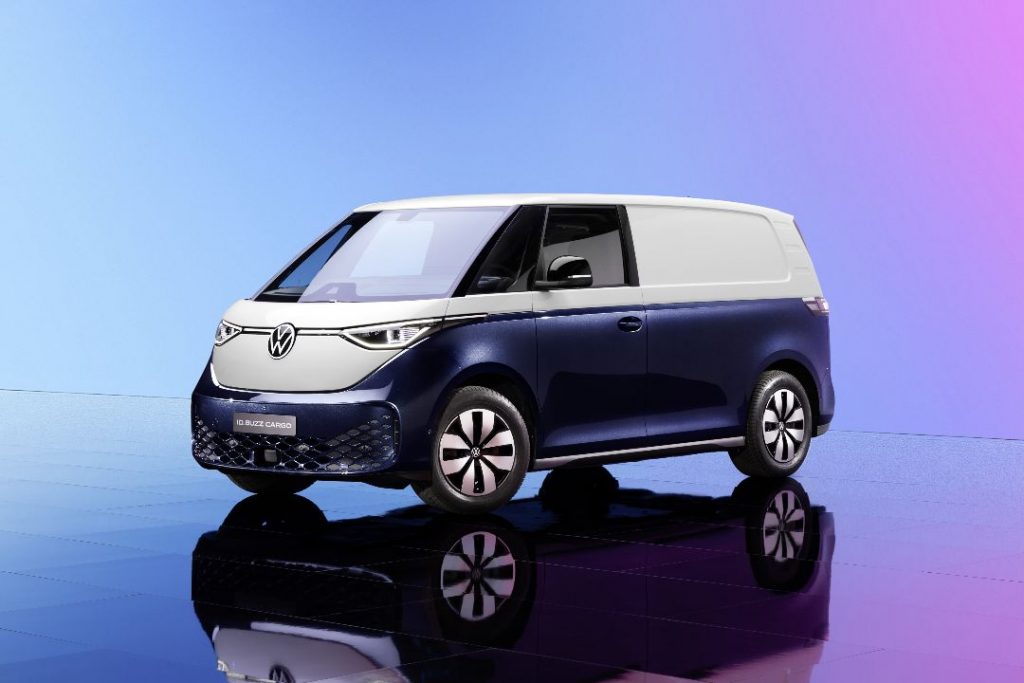
The Volkswagen ID Buzz Cargo is a brand-new electric van that takes its inspiration from the classic Volkswagen Type 2 campervan.
It sits between the Volkswagen Caddy and the Volkswagen Transporter T6.1 in the Volkswagen range in terms of its size and is built on Volkswagen’s shared MEB electric drivetrain platform. Despite being a van, with a load volume of up to 3.9m3 and 650kg, the ID Buzz Cargo actually borrows many of its features from Volkswagen’s passenger car models including the Volkswagen ID.3 and the Volkswagen ID.4 passenger cars.
A 150kW motor powers the van, producing 310Nm of torque in the process. There is currently just one battery option, a 82kWh unit providing a claimed range of up to 256 miles. Charging from 5% to 80% can be done in less than 30 minutes thanks to a maximum charge rate of up to 170kW on a DC charger.
For those needing more payload, a smaller battery pack size is likely to be added to the line-up reducing range but pushing capacity to around 750kg.
Two trim levels are available, Commerce and Commerce Plus, with entry-level models receiving a high level of equipment including LED headlight, a heated driver’s seat, front and rear parking sensors, 10” touchscreen and wireless App-Connect for Apple CarPlay and Android Auto. Commerce Plus models get Adaptive Cruise Control, keyless entry, Park Assist Plus with memory function which allows you to effectively record difficult parking manoeuvres to be automatically repeated. There are also safety features including driver assistance systems like Travel Assist, Lane Assist, Side Assist and Emergency Assist.
Prices start from £38,125 and includes three services and an MoT.
VERDICT: The Volkswagen ID Buzz Cargo’s biggest problem is its price but if you can get over that it is a brilliantly trendy, practical and accomplished van. It’s really a passenger car at heart, but unlike so many where the seats are removed and some blacked out windows added, the ID Buzz Cargo has been co-developed as one so it gets the best of both worlds. Loads of smart tech, super-fast charging, and reasonably good at both volume and payload. It's very nearly the best small electric van of 2022.
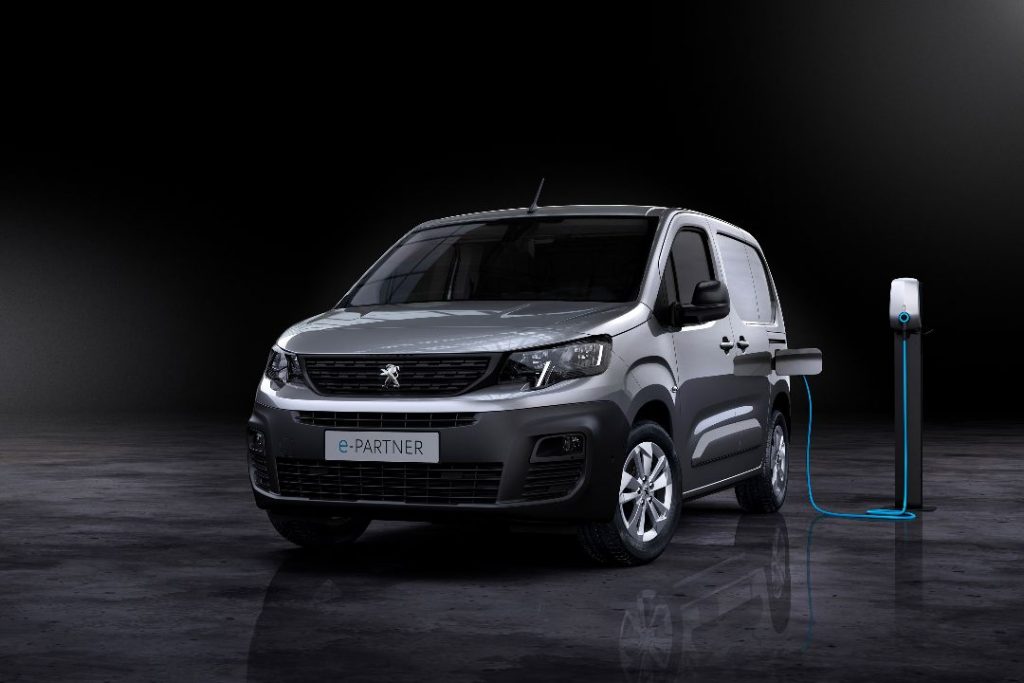
The city vans of Citroen, Peugeot, Toyota and Vauxhall have taken the successful underpinnings of the medium-sized electric van from Stellantis and applied it to the compact packaging of their small van range.
Built in France for Stellantis siblings Citroen, Peugeot and Vauxhall and also produced on behalf of Toyota, the van leads the small van sector with a 171 mile range from a 50kWh battery pack and is paired to a 100kW (136bhp) motor producing 260Nm of torque. Despite being small, the vans offer a load capacity of 4.4m3 thanks to a load-through bulkhead with folding passenger seat which extends the 3.3m3 and 3.9m3 capacities of the standard and long wheelbase vans.
The four vans can also have a very respectable payload of up to 800kg and have a towing capacity of 750kg. For added versatility, they can be specified with a E-Power take off system to power conversions such as fridge units. Charging can be carried out using 100kW charger, taking the battery from zero to 80% in 30 minutes.
The van’s comfortable cabin is focused around the driver with an angled 8in infotainment and navigation touchscreen, and includes several premium features like wireless phone charging and a Surround Rear View system giving a 360-degree view around the van. In total there are 18 driver assistance systems designed to make the van safer for both drivers and other road users.
Prices start from around £27,000 depending on the brand.
VERDICT: These small vans have been on sale for more than a year, coming to market in the autumn of 2021 but they still manage to deliver what the electric audience needs. They’ve not been left behind by the changes in technology either, with powerful motors, decent battery range and the option of both standard and high specification models.
If you want a decent all-rounder these three make a good bet, and the Toyota even comes with a longer warranty.
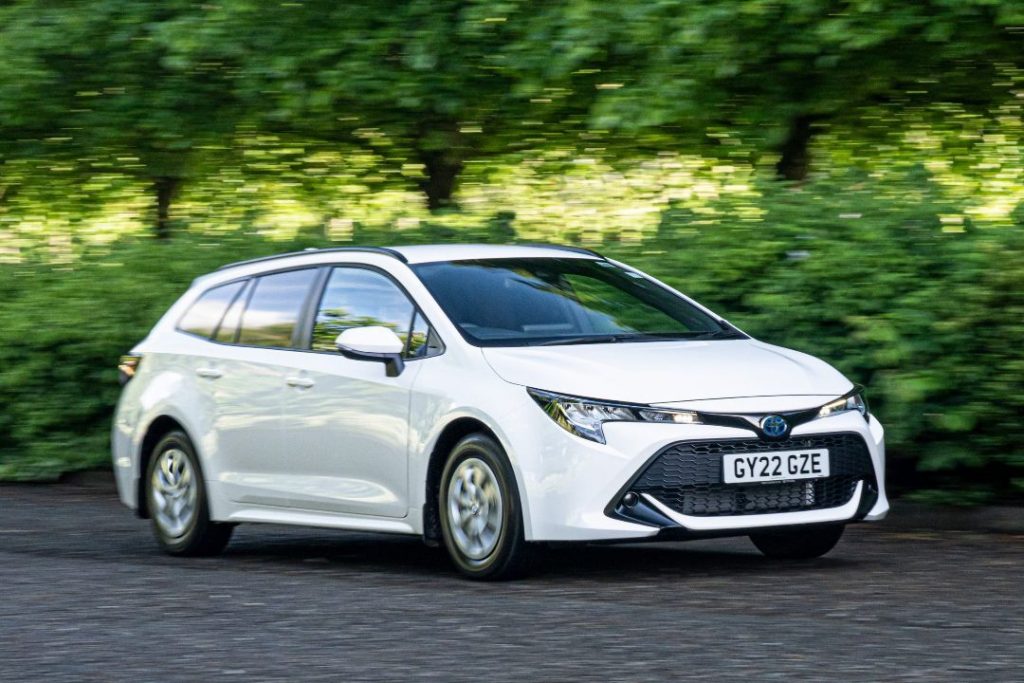
It’s been years since the Astravan disappeared from sale but the Toyota Corolla Commercial Hybrid van more than makes up for the shortfall.
Based on the Corolla Touring Sports estate passenger car, it is a full self-charging hybrid electric van. It looks, feels and drives like a car, but has a healthy 1.3m3 loadspace area in place of the rear seats.
Power comes from a 1.8-litre petrol engine and is paired to a 53kW electric motor, together the petrol hybrid Corolla Commercial produces up to 90kW (120bhp) and 142Nm of torque.
It’s the only engine choice and there’s also only one trim level but the interior is far from your typically commercial vehicle.
The Corolla Commercial gets a decent level of equipment including heated seats, dual-zone climate control and a reversing camera. There’s also LED headlights as standard. When it comes to safety, the Corolla Commercial Hybrid isn’t short on features. It gets adaptive cruise control, high beam assist headlights and lane keep assist as standard. Lane Trace Assist also helps to keep the van in the centre of the lane even while turning slight bends, and there’s Road Sign Assist to remind you of the speed limits with an audible or visual warning.
In the rear, the loadspace floor gets a rubber lining and there is a full-height steel bulkhead to protect the front seat occupants. There’s also an interior light and a 12v power outlet but the important figure is the 425kg payload and 750kg towing capacity.
Prices start from £22,149, excluding VAT.
VERDICT: A self-charging hybrid has managed to sneak into our best small electric vans of 2022 review but with good reason. That’s because the Toyota Corolla Commercial Hybrid is one hell of a package.
It’s a car to van conversion like any other with some questionable sticky window coverings but average fuel consumptions knocking on the door of 60mpg in the real world can’t be sniffed at.
It doesn’t suit everyone, but it brings back a niche segment and adds an electric spin to it. We’re grateful for the effort.
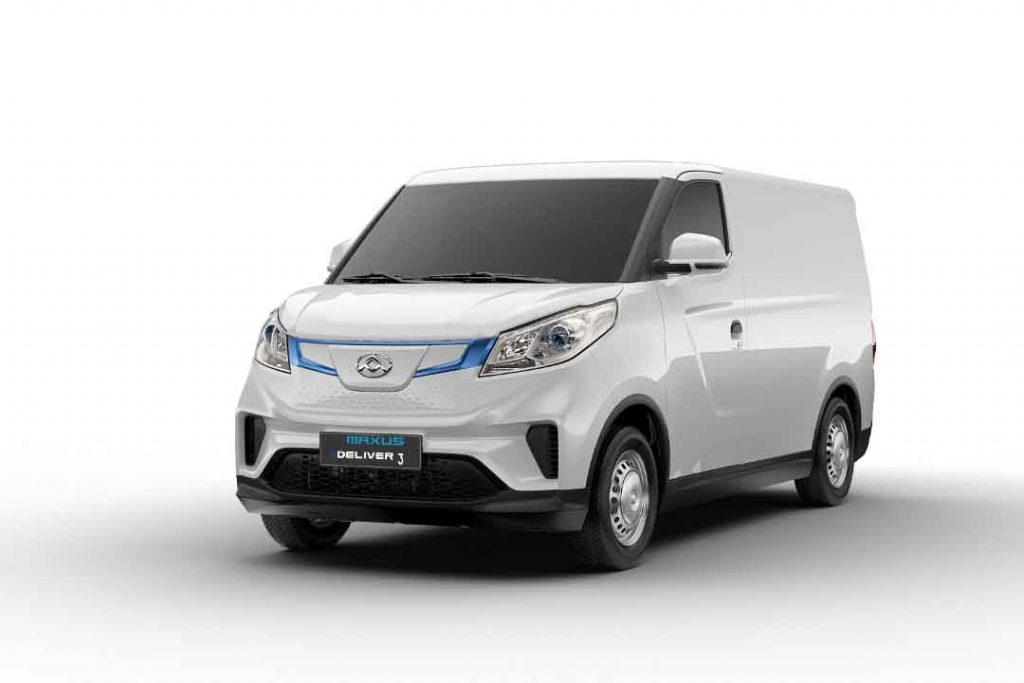
Arguably the first electric van to be launched that was conceived purely as an EV, the Maxus e Deliver 3 was nevertheless a big departure for Chinese-owned Maxus whose line-up had previously consisted of both diesel and electric models.
Designed from the ground-up as a pure electric van with a heavy focus on its aerodynamic performance, the e Deliver 3 has a claimed range of up to 213 miles for its WLTP city range and 151 miles for the combined WLTP standard. It has the option of two battery packs with either 35kWh or 50kWh cells and is paired to a 90KW motor producing 255Nm of torque.
It can carry up to 945kg of payload and despite only being available in a short wheelbase has a volume of 4.8m3. It is the smaller sibling to the large electric van Maxus E Deliver 9 and Maxus E Deliver 7.
Charging times using a DC rapid charger will see the battery level go from 5% to 80% in just 45 minutes, while a three-phase 11kW AC charge will take around five hours.
Standard features include air conditioning, built-in Sat Nav, smartphone mirroring with Apple CarPlay and Android Auto compatibility as well as USB and Bluetooth connectivity.
Operators can also have the e Deliver 3 as a chassis cab and can get real-time telematic data through a partnership with Geotab.
Its most appealing feature, however, is its price with models starting from just £27,000 with a government grant.
VERDICT: We’d love to put the e Deliver 3 much higher in our list of the best small electric vans you can buy in 2022 but it’s not quite the complete package. The battery range is impressive, and there’s adequate power from the motor, but its all the bits and piece in the cabin that let it down. An infotainment system that is frustrating (when it works) and a other little software gremlins too.
Launched in 2020 it fills a natural hole left by the Nissan eNV200 which is definitely a good thing, but it can’t match the finesse of the newer models.
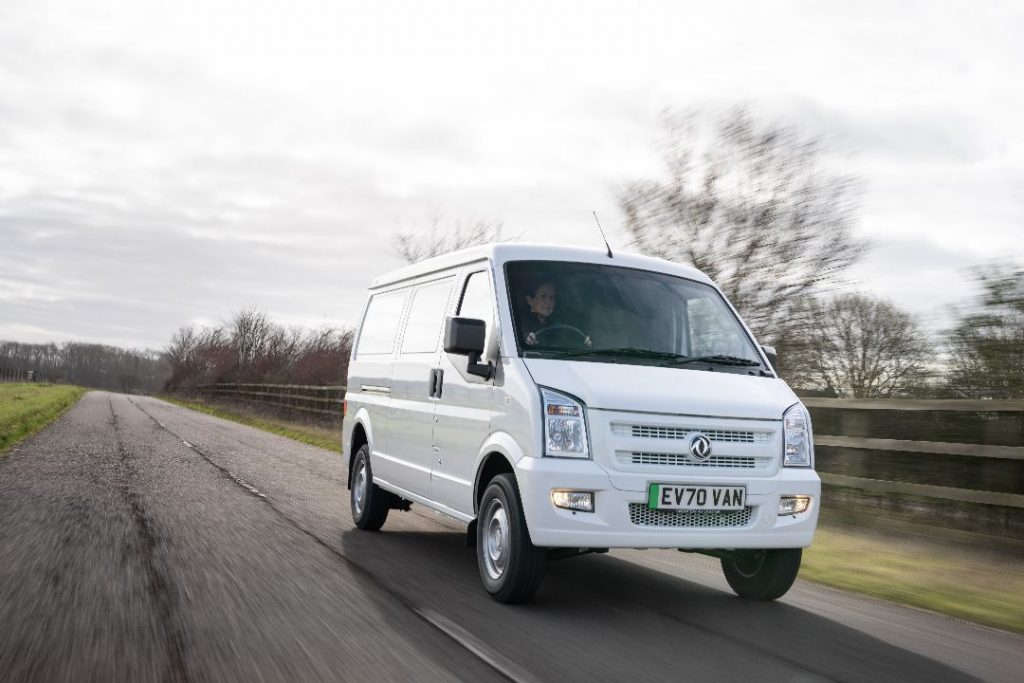
Chinese-made DFSK vans have made a comeback in the UK through importer Innovation Automotive with the quirky midi-van offering a cheap entry-level price to electric van ownership.
The DFSK EC35 looks like a typical Japanese-style microvan with high sides and a narrow width of just 1680mm. It’s unusual proportion don’t mean it is lacking in space with a maximum loadspace volume of 4.8m3 and an equally impressive payload capacity of 1,015kg thanks to its lightweight 1585kg kerbweight. It has a hinged rear tailgate and gets twin sliding doors as standard.
Power comes from a 60kW (80bhp) motor paired to a 39kWh lithium-ion battery with 200Nm of torque. While options are few and far between, one thing you can choose is the maximum speed limit of the van, with a 50mph limited model or a faster 62mph van. Depending on which version you choose will dictate how far you might be able to travel with a claimed range of 101 miles or 166 miles, according to the WLTP testing cycle, for the slow and fast versions respectively. The DFSK EC35 is able to be charged at a maximum rate of 40kW with the battery level going from zero to 80% in around 60 minutes. Topping up the battery to 100% on a 40kW charger will take 90 minutes, while charging from a 7kW wall box will take 6 hours.
Prices start from £20,999 excluding VAT.
VERDICT: Being entirely honest with you, the DFSK is only on the list out of courtesy. It’s not a particularly good van.
But, it will certainly do the job for the right sort of person. If you need to move things around at a walking pace, don’t want to go all that far or need to charge up that often it might just be the van for you.
If you spend more time out of the van than in it, then give it a chance. The price tag is too good not to consider it.
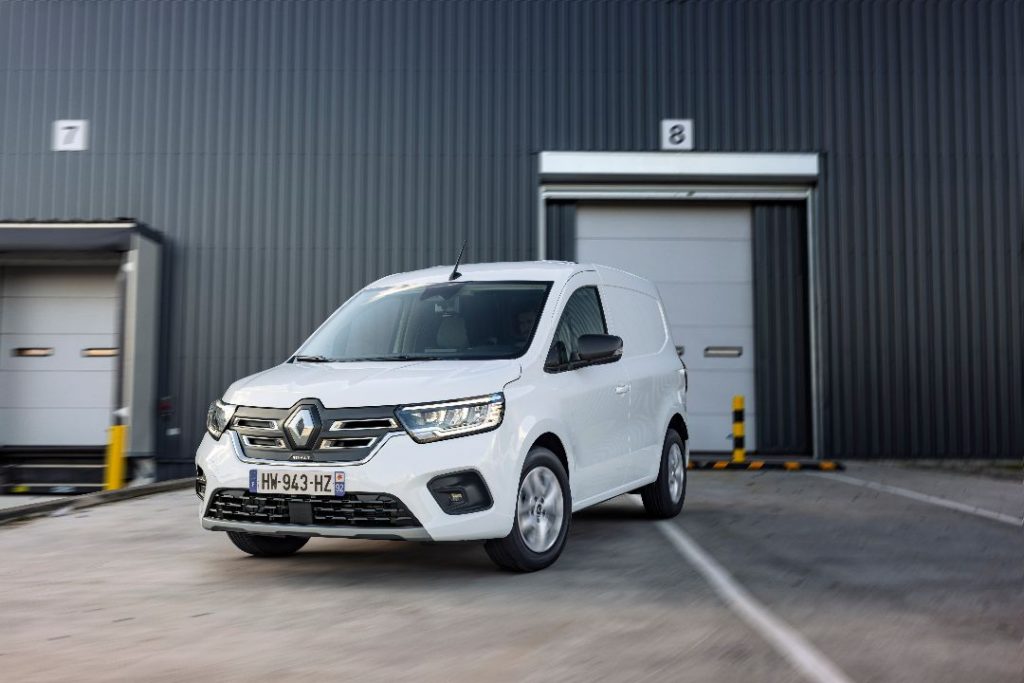
The Renault Kangoo is the oldest and most established name in the small electric van field but the latest version shares only its name with the trailblazer model launched in 2012.
The latest van returns with a new E-Tech name to reflect the rest of the electrified Renault models and is accompanied by two cousins with versions from Mercedes-Benz and Nissan. The three models offer a different take on the electric city van, with Mercedes opting for a more upmarket interior and more standard safety systems than the Renault, while Nissan plays off its warranty support and value.
All three vans, however, use the same 90kW motor paired to a 45kWh battery pack. Range for the vans is 186 miles, while charging can be carried out using an 80kW supply to add more than 100 miles in less than 30 minutes. Slower 22kW charging is also possible as well as a from domestic single-phase 7kW supply though a wallbox which is said to take six hours.
The van is available in two wheelbase lengths with the standard van having a 3.9m3 load volume and the long-wheelbase model up to 4.9m3 of capacity. Payload for regular vans will be up to 600kg but thanks to a higher gross vehicle weight the larger models can transport up to 800kg. They also have a 1,500kg towing capacity.
Prices start at around £30,000 for the Nissan version.
VERDICT: The diesel Renault Kangoo and Mercedes-Benz Citan are both excellent vans, and while the Nissan Townstar Electric is only available as a petrol model, the real strength of these models is the electric version.
Quiet, comfortable and way bigger than the previous generation vans, the Kangoo E-Tech, eCitan and Townstar electric really are the best small electric vans of 2022.
In summary, there's a large amount of choice in the small van market at the moment, and there's bound to be more with a Ford E-Transit Connect likely to be added to Ford's electric van range.
Nissan has radically altered its naming policy for its light commercial vehicles van range, ditching its NV plus number names in favour of some previously used favourites.
The introduction of the new Renault Kangoo-based Nissan Townstar has prompted a complete change to the Nissan LCV van portfolio names.
The Nissan NV400 becomes the Nissan Interstar.
Nissan NV300 becomes the Nissan Primastar.
The Nissan NV250 becomes the Nissan Townstar.
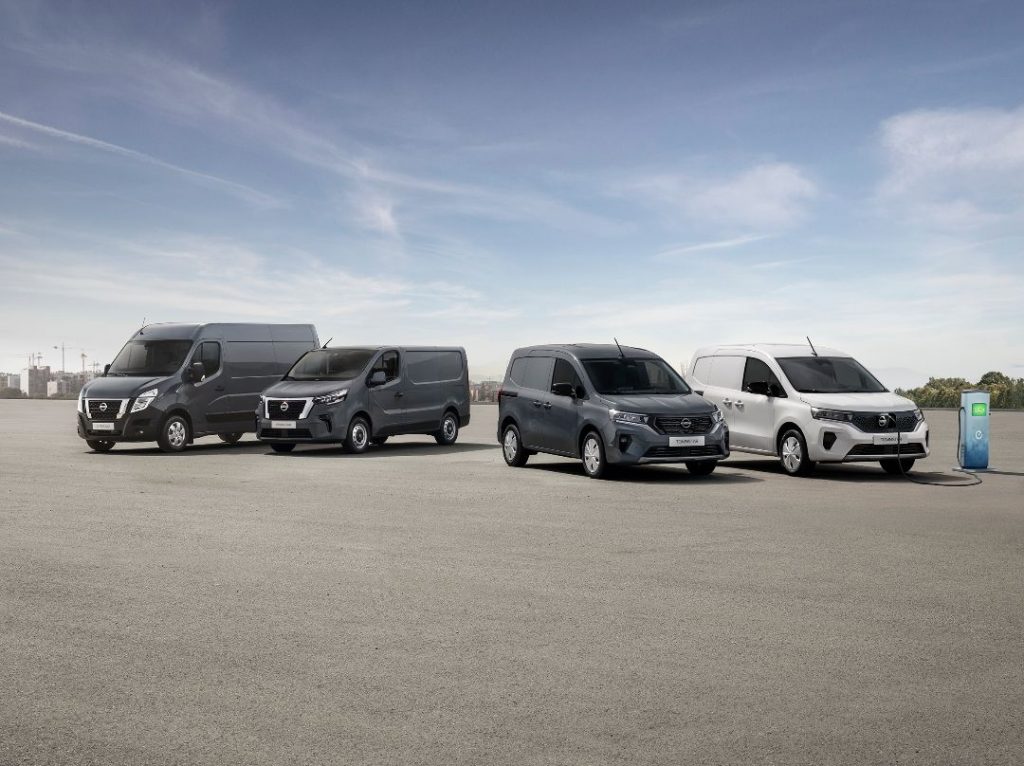
The change is a return of the Interstar and Primastar names which were once used to denote the large and medium vans. The new Nissan Townstar will also be available as both an electric and petrol engine van.
All three models are based on vans from the Renault-Nissan Mitsubishi Alliance. That sees all three brands share platforms and technology.
The large-sized Nissan Interstar is based on the Renault Master.
The medium-sized Nissan Primastar is based on the Renault Trafic.
The compact city van Nissan Townstar is based on the Renault Kangoo.
Read our new van reviews
Despite the Nissan Townstar being a replacement for the Nissan NV250, it is also a a replacement for the Nissan eNV200. Nissan dropped the diesel variant of the NV200 in 2020 but kept the electric Nissan eNV200. The diesel van to follow the NV200 was named the NV250 and was based on the previous generation Renault Kangoo.
The new naming strategy sees more sense returned to the range. The eNV200 name is laid to rest, and an electric Townstar van brought in to the Nissan range to replace it.
The Nissan Townstar is built in Renault’s Maubeuge plant – about three hours from Paris close to the Belgium borde. Townstar is assembled alongside the Renault Kangoo and Mercedes-Benz Citan and built under licence by the French for both parties.
Nissan Primastar is built at the Renault Sandouville plant. The plant is near the French city of Le Harve.
The Nissan Interstar large van is built at Renault's Batilly plant near Metz, and close to the border with Luxembourg and Germany.
Nissan is also continuing to differentiate its LCV van range and retains its 5-year warranty for vans. All models in the line-up will get the extended cover.